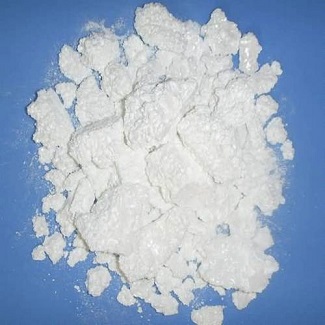| Physical Properties | The octahydrate is a white silky solid; tetragonal crystals consisting of tetramers; effloresces; refractive index 1.552; loses six water molecules at 150°C; becomes anhydrous at 210°C; decomposes at 400°C; soluble in water; aqueous solution acidic; also soluble in alcohol and ether; slightly soluble in hydrochloric acid.

|
| Uses | Zirconyl chloride is used to make pigment toners and improve properties of color lakes of acid and basic dyes. Also, it is used to prepare body deodorants and antiperspirant, water repellant, dye precipitant, catalysts, and many zirconium compounds.
|
| Preparation | The compound is prepared by dissolving zirconium tetrachloride, ZrCl4, or sodium zirconate, Na4ZrO4, in hydrochloric acid solution followed by evaporation to obtain crystals of octahydrate.
Also, the compound can be prepared by reacting zirconium tetrachloride with chlorine oxide:
ZrCl4 + Cl2O → ZrOCl2 + 2Cl2
|
| Toxicity | Moderately toxic by ingestion, intraperitoneal and subcutaneous routes.
LD50 (intraperitioneal) (rat): 400mg/kg
|
| Chemical Properties | Zirconium oxychloride exists as white silky crystals, soluble
in water and alcohol. With water, the octahydrate is formed
as tetragonal white needles. It is extremely hygroscopic
and decomposes to zirconium tetrachloride (ZrCl4) and zirconium oxide (ZrO2) at 250 C. It is also formed as the
octahydrate [13520-92-8] as white, tetrahedral crystals that
are very soluble in water, ethyl alcohol, ether, and methanol,
among others, but only slightly soluble in hydrochloric acid.
When heated to decomposition, it emits toxic fumes of
hydrogen chloride. |
| Uses | Building block for a new series of mixed zirconium phosphonates which may have uses in catalysis, ion exchange or photophysics. |
| Uses | Textile, cosmetic and grease additive, antiperspirant,
water repellents, chemical reagent, zirconium
salts, in lakes and toners of acidic and basic
dyes, oil-field acidizing aid. |
| Definition | ChEBI: Zirconyl chloride is a zirconium coordination entity consisting of zirconium(IV) bound to oxygen via a double bond and to two chlorines. |
| Reactivity Profile | Acidic salts, such as Zirconium oxychloride, are generally soluble in water. The resulting solutions contain moderate concentrations of hydrogen ions and have pH's of less than 7.0. They react as acids to neutralize bases. These neutralizations generate heat, but less or far less than is generated by neutralization of inorganic acids, inorganic oxoacids, and carboxylic acid. They usually do not react as either oxidizing agents or reducing agents but such behavior is not impossible. Many of these compounds catalyze organic reactions. |
| Health Hazard | Has only a mild pharmacological action. Inhalation of dust may irritate nose and throat. Contact with eyes or skin causes irritation. |
| Flammability and Explosibility | Notclassified |
| Safety Profile | Poison by
intraperitoneal route. Moderately toxic by
ingestion and subcutaneous routes.
Questionable carcinogen with experimental
neoplastigenic data. When heated to
decomposition it emits toxic fumes of Cl-.
Used as an antiperspirant. See also
ZIRCONIUM COMPOUNDS and
CHLORIDES. |
| Purification Methods | Crystallise it repeatedly from 8M HCl to give ZrOCl2.8H2O (see below). On drying, ZrOCl2.6H2O, m 150o, is formed. The product is not free from hafnium. [Blumenthal J Chem Ed 39 607 1962.] |



